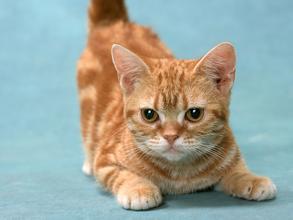(单词翻译:单击)
听力文本
You're listening to NEWS Plus Special English, I'm Paul James in Beijing.
A cat-and-mouse game played out in a Chinese village some 5,300 years ago is helping scientists understand how wild felines transformed into the tame pets we know today.
Scientists believe that, in fact, it was the cat's appetite that started it down the path to domestication.
The grain stored by ancient farmers was a magnet for rodents. And that drew wild cats into villages to hunt the little critters. Over time, wild cats adapted to village life and became tamer around their human hosts.
That's the leading theory, anyway, for how wild cats long ago were transformed and became ancestors of today's house cats. That happened in the Middle East, rather than China. But bones from the Chinese village back up the idea that felines took on the pest-control job in ancient times.
Researcher Fiona Marshall of Washington University in St. Louis is an author of a report on the fossil research, published online by the Proceedings of the National Academy of Sciences in the US.
The study, focused on an agricultural village in northern China, comes from a poorly understood time in the history of cats. The first evidence of domesticated cats comes much later, in Egyptian artwork from about 4,000 years ago.

So what went on in that village?
Researchers found signs that rodents were threatening the village grain supply. Storage vessels were designed to keep them out, and rodents had burrowed into a grain-storage pit.
In the ancient feline bones, chemical signatures indicated that the cats had eaten animals that in turn had fed on millet, a grain crop known to be harvested by the villagers. So apparently, the cats were indeed going after the rodents.
Marshall says it's not yet clear whether the cats were from a local wild population, or were already domesticated and had been brought in from elsewhere. Either way, she says, it shows that ancient cats filled the niche at the heart of the hypothesis about how domestication began.
Greger Larson of Durham University in England called the new work "an important step forward." He says few studies have focused on how cats became domesticated, in contrast to dogs, pigs and sheep.
This is NEWS Plus Special English.
中文翻译
您正在收听NEWS Plus慢速英语,我是保罗·詹姆斯,从北京为您带来报道。
约5300年前中国乡村进行的猫捉老鼠游戏将帮助科学家理解野猫是转变为今天这种温驯宠物的过程。
科学家认为,事实上是猫咪的食欲促使它走上了驯化的道路。
古代农民储藏的谷物吸引着鼠类。因此将野猫吸引至村庄来寻找鼠类。随着时间的推移,野猫适应了乡村生活,在人类面前变得越来越温驯。
这是多年前的野猫是如何成为成今天家猫的祖先这一问题的主导理论。不过其实这发生在中东,而不是在中国。而在中国乡村发现的骨骼则证实了猫曾在古代承担过虫害防治的工作。
圣路易斯华盛顿大学的研究员菲奥娜·马歇尔是化学研究报告的其中一名作者,这份报告由《美国国家科学学院院刊》在线发表。
这一研究重点关注中国北部的农业村庄,关注猫类历史中那段我们知之甚少的时间。第一份有关家猫的证据出现的很晚,在大约4000年前的埃及艺术品上找到了相关证据。
那那个村庄里发生了什么事?
研究人员发现了鼠类威胁该村庄谷物供应的证据。储物容器的设计使鼠类无法接近,于是鼠类就钻入了储藏谷物的地窖。
古代猫类骨骼的化学特征表明,猫类以食用谷子的动物为食,而这种谷物就是该村村民收获的作物。所以显然,猫类确实在追老鼠。
马歇尔表示,目前并不清楚这些猫是来自当地的野生群体,还是已经被驯养的来自其他地方的猫。她表示,无论是哪种都表明古代猫类填补了家猫起源这种假设的生态位。
英国杜伦大学的格雷格·拉尔森称这种网络为“重要的一步”。他表示,相比狗、猪和羊,很少有研究关注猫是如何成为家猫的。
这里是NEWS Plus慢速英语。
译文属可可英语原创,未经允许,不得转载
重点讲解
重点讲解:
1. transform into
转换;改变;改造;
eg. In different eras, these three goals would transform into different forms.
在不同的时期,这三者会转化成不同的型态。
eg. Water may be transformed into ice.
水可以转变为冰。
2. adapt to
适应;
eg. Yulan magnolia can adapt to a variety of soils.
玉兰花能适应各种土壤。
eg. I do not think I 'll ever adapt to this culture.
我恐怕永远也适应不了这种文化。
3. back up
支持,证实(某种说法);
eg. Radio signals received from the galaxy's centre back up the black hole theory.
从该星系中心收到的无线电信号证实了黑洞理论。
eg. Becker's theory is powerful, and there is evidence to back it up, too.
贝克尔的理论十分有力,也有证据支持。
4. take on
承担,接受(尤指艰巨工作或重大责任);
eg. The vice-president must now take on the mantle of supreme power.
副总统现在必须承担起最高权力的重任。
eg. But I'm not qualified to take on the job.
但我没有条件担任这项工作。
5. in turn
继而;转而;反过来;
eg. Theory is based on practice and in turn serves practice.
理论的基础是实践,反过来理论又为实践服务。
eg. This, in turn, makes speech and written communication richer.
这也因此使得口语及文字沟通变得更加丰富。
6. go after
追逐;追求;追击;
eg. If I could have a look at these files, I could go after those other wankers.
如果我可以看看这些文件,我就可以追踪那些贩毒者。
eg. The police went after the escaped prisoner.
警察追赶逃犯。
7. either way
(两种情况中)不论发生哪一种情况;
eg. The sea may rise or the land may fall; either way the sand dunes will be gone in a short time.
可能会出现海平面上升或陆地下沉:不论发生哪种情况,沙丘都会在短时间内消失。
eg. Either way, the rumpus will die down in time.
无论你做何选择,喧嚣迟早都会平息。
8. in contrast to
相比之下;与…相反;
eg. In contrast to their pessimism, I myself was feeling a remarkable euphoria.
与他们的悲观情绪相反,我却感到异常欣快。
eg. In contrast to those professional writers, Gray's literary output was small.
与其余专职作家不同,格雷作品极少。


